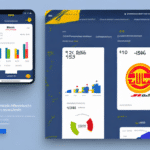Importance of Data-Driven Insights in Shipping Rate Negotiations
In the competitive landscape of shipping logistics, data-driven insights are crucial for businesses aiming to negotiate better rates with providers like DHL eCommerce. Leveraging data allows companies to gain a comprehensive understanding of their shipping patterns, identify cost-saving opportunities, and establish a foundation for effective negotiations.
Empowering Negotiations with Information
Data serves as a powerful tool in negotiations. By analyzing shipping data, businesses can assess whether they are receiving competitive rates and identify specific areas where costs can be reduced. This information provides a concrete basis for requesting lower prices from DHL eCommerce, ensuring that negotiations are grounded in factual evidence rather than assumptions.
Optimizing Shipping Processes
Beyond negotiation, data-driven insights help businesses streamline their shipping operations. Analyzing shipping data can reveal inefficiencies within the supply chain, allowing companies to make informed adjustments that improve delivery times and reduce overall costs. Enhanced operational efficiency not only leads to cost savings but also boosts customer satisfaction and loyalty.
Key Factors Influencing DHL eCommerce Shipping Rates
Understanding the elements that affect shipping rates is essential before entering negotiations. Key factors include:
- Package Weight: Heavier packages typically incur higher shipping costs.
- Destination: Shipping to remote or international locations may result in increased rates.
- Shipping Speed: Expedited shipping services generally cost more than standard delivery.
- Product Value: High-value items may require additional insurance, affecting the overall cost.
By analyzing historical shipment data, businesses can identify trends and prepare effectively for rate negotiations, ensuring they address the most significant cost drivers.
Impact of Shipment Volume
The volume of shipments plays a critical role in determining shipping rates. Businesses with high shipment volumes often have greater negotiating power, enabling them to secure more favorable rates. Additionally, DHL eCommerce may offer discounts to customers who consolidate their shipping needs, making it advantageous to centralize shipping operations.
Assessing Customer Service and Support
While cost is a primary consideration, the quality of customer service and support provided by DHL eCommerce is equally important. Reliable and responsive support ensures that shipments are handled efficiently and any issues are promptly addressed. Evaluating the level of service can help businesses decide whether the cost savings are worth potential trade-offs in service quality.
Collecting and Analyzing Shipping Data for Negotiations
Effective negotiations rely on comprehensive data collection and analysis. Businesses can utilize various tools to gather the necessary data, including:
- Automated shipping software
- Carrier dashboards
- Analytics platforms
Once collected, it's essential to analyze the data to identify trends, outliers, and opportunities for cost savings. Comparing this data against industry benchmarks can provide additional context, enabling businesses to position themselves advantageously during negotiations.
Tailoring Data Analysis to Business Needs
Every business has unique shipping requirements. For instance, companies frequently shipping fragile or oversized items may need to negotiate specialized packaging or handling services. By customizing data analysis to reflect specific needs, businesses can ensure that negotiation strategies address their most critical shipping challenges effectively.
Leveraging Historical and Real-Time Shipping Data
Utilizing Historical Data for Strategic Negotiations
Historical shipping data offers valuable insights into past shipping behaviors and trends. By examining this data, businesses can identify consistent patterns, such as frequent shipments of lightweight packages, which can be leveraged to negotiate lower rates tailored to their specific shipping profiles.
Additionally, historical data can highlight areas for operational improvements. For example, identifying regions where shipments are consistently delayed can prompt discussions with DHL eCommerce to optimize routing or adjust delivery schedules, resulting in more efficient and cost-effective shipping processes.
The Role of Real-Time Data in Ongoing Negotiations
Real-time shipping data provides up-to-the-minute information on shipping operations, allowing businesses to respond swiftly to market changes. This agility is particularly beneficial during negotiations, as it enables companies to adjust their strategies based on current demand fluctuations and shipping trends.
Moreover, real-time tracking capabilities enhance transparency and accountability. Businesses can monitor shipments closely, ensuring timely deliveries and proactively addressing any issues that arise. This level of control not only improves operational efficiency but also strengthens the negotiating position by demonstrating a commitment to effective shipping management.
Comparative Analytics: Benchmarking Against Competitors
Comparative analytics involves evaluating your shipping rates and practices against those of similar businesses in the industry. This benchmarking process helps determine whether your shipping rates with DHL eCommerce are competitive and fair.
By understanding how your shipping costs compare to industry standards, you can identify areas where you may be overspending and adjust your negotiation strategies accordingly. Benchmarking also provides tangible evidence to support requests for rate reductions, making your negotiations more compelling.
Identifying Trends Through Comparative Analysis
Tracking changes in shipping rates over time through comparative analytics allows businesses to anticipate market fluctuations and adjust their strategies proactively. Staying informed about industry trends ensures that your shipping operations remain cost-effective and aligned with best practices.
Building Strong Relationships with DHL eCommerce
Establishing a robust relationship with DHL eCommerce is instrumental in securing favorable shipping rates. A strong partnership can lead to exclusive rate offerings, priority support, and tailored services that meet your business's specific needs.
Effective communication, regular feedback, and mutual understanding are key components of a successful relationship. By demonstrating your value as a reliable customer and maintaining open lines of communication, you can foster trust and collaboration with DHL eCommerce, thereby enhancing your negotiating power.
Understanding DHL eCommerce’s Business and Industry
Staying informed about DHL eCommerce’s business strategies and industry trends enables you to align your shipping needs with their offerings. This alignment facilitates more meaningful discussions during negotiations and helps in identifying mutually beneficial solutions.
Best Practices for Presenting Data in Shipping Rate Negotiations
Presenting data effectively is crucial in negotiations. Clear and organized data presentation helps convey your points convincingly and supports your negotiation objectives.
Utilize visual aids such as charts, graphs, and tables to illustrate key data points. Visuals make complex information more accessible and can highlight significant trends and cost-saving opportunities effectively.
Ensure that your data presentation is structured logically, starting with an overview of your shipping operations, followed by detailed analysis, and ending with specific negotiation points. This approach builds credibility and demonstrates a thorough understanding of your shipping needs.
Highlighting Cost Savings and Efficiency Improvements
Emphasize potential cost savings and operational efficiencies that can result from a more favorable shipping agreement. Present data on shipping volumes, delivery times, and any specialized requirements to illustrate how a partnership with DHL eCommerce can be mutually beneficial.
Understanding Market Trends and Their Impact on Shipping Rates
Market dynamics significantly influence shipping rates. Factors such as carrier capacity, fuel prices, and global events can affect the cost and availability of shipping services.
Staying abreast of these trends allows businesses to anticipate changes in shipping costs and adjust their strategies accordingly. For instance, fluctuations in fuel prices can impact shipping rates, and understanding these patterns can help in negotiating more stable and predictable rates.
Adapting to Global Events
Global events like pandemics, natural disasters, or economic shifts can disrupt supply chains and alter shipping demand. Businesses that monitor these events and adapt their shipping strategies proactively can mitigate adverse effects and maintain cost-effective operations.
Setting Realistic Goals and Measuring Negotiation Success
Establishing realistic and achievable goals is essential for successful negotiations. While striving for cost savings, it’s important to acknowledge the value DHL eCommerce brings as a shipping partner and aim for a balanced agreement that benefits both parties.
Setting clear objectives and maintaining open communication fosters a collaborative negotiation environment, increasing the likelihood of reaching a mutually beneficial agreement.
Long-Term Benefits of Successful Negotiations
A well-negotiated shipping agreement can lead to long-term advantages, including improved service levels, enhanced operational efficiency, and a stronger partnership with DHL eCommerce. These benefits contribute to sustained cost savings and operational success over time.
Measuring the Success of Your Data-Driven Negotiation Strategy
To evaluate the effectiveness of your negotiation strategy, it’s important to track and measure key performance indicators (KPIs). Metrics such as cost savings, shipping times, and shipment volume provide tangible evidence of the strategy’s success.
Regularly monitoring these metrics allows businesses to assess the impact of their negotiations and make necessary adjustments to maintain or enhance their shipping operations.
Incorporating Customer Satisfaction Metrics
Customer satisfaction is a vital metric in measuring the success of your shipping strategies. Gathering feedback through surveys and monitoring customer experiences can provide insights into how shipping practices affect overall satisfaction. Positive shipping experiences lead to increased customer loyalty and retention, reinforcing the value of effective shipping rate negotiations.
Conclusion
Leveraging data-driven insights is essential for businesses aiming to negotiate better shipping rates with DHL eCommerce. By understanding key factors, collecting and analyzing relevant data, and building strong relationships, businesses can secure favorable rates and optimize their shipping operations. Staying informed about market trends and setting realistic negotiation goals further enhances the effectiveness of this strategy. Ultimately, a data-driven approach not only leads to cost savings but also fosters long-term partnerships and improved customer satisfaction.




















